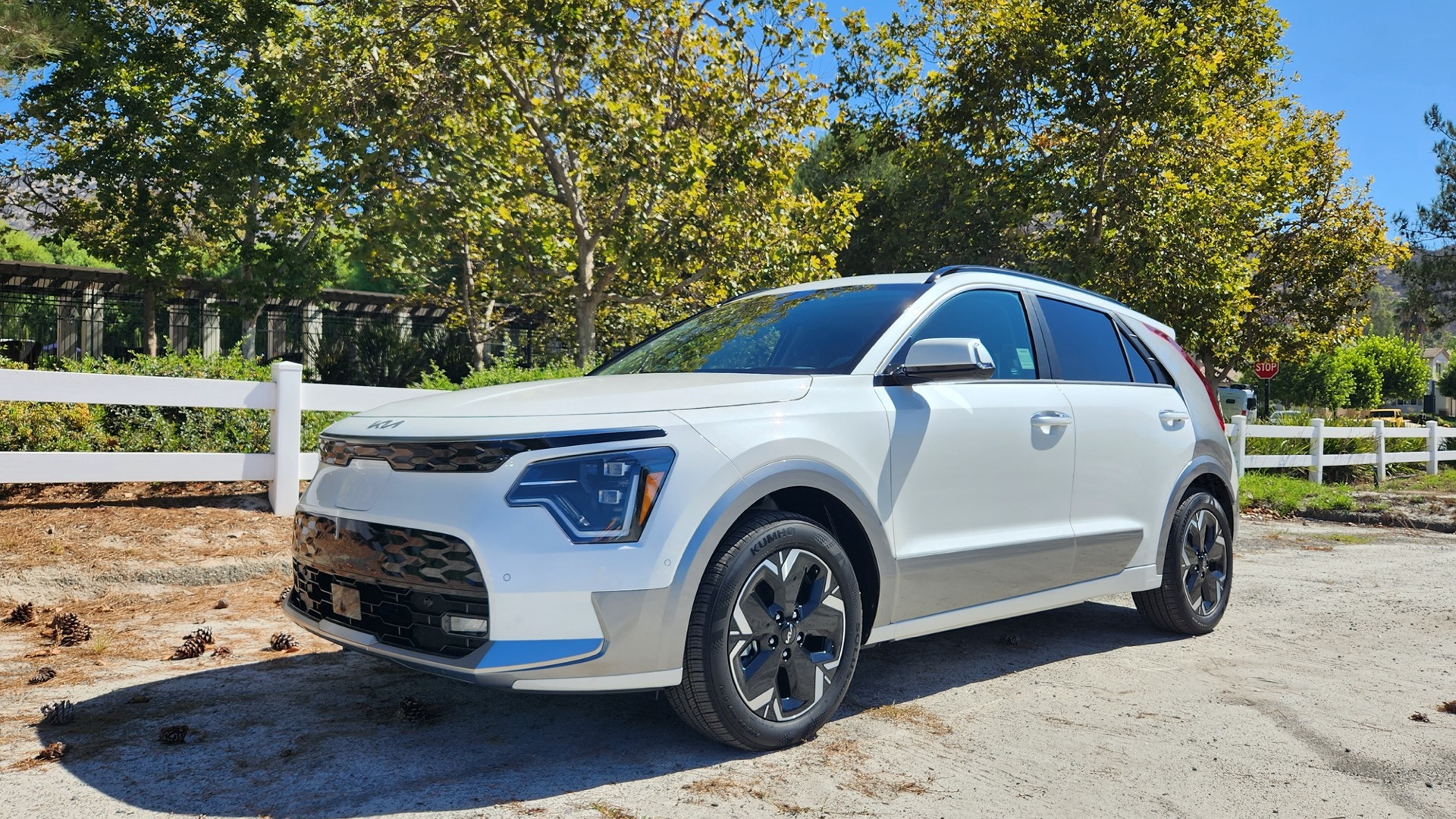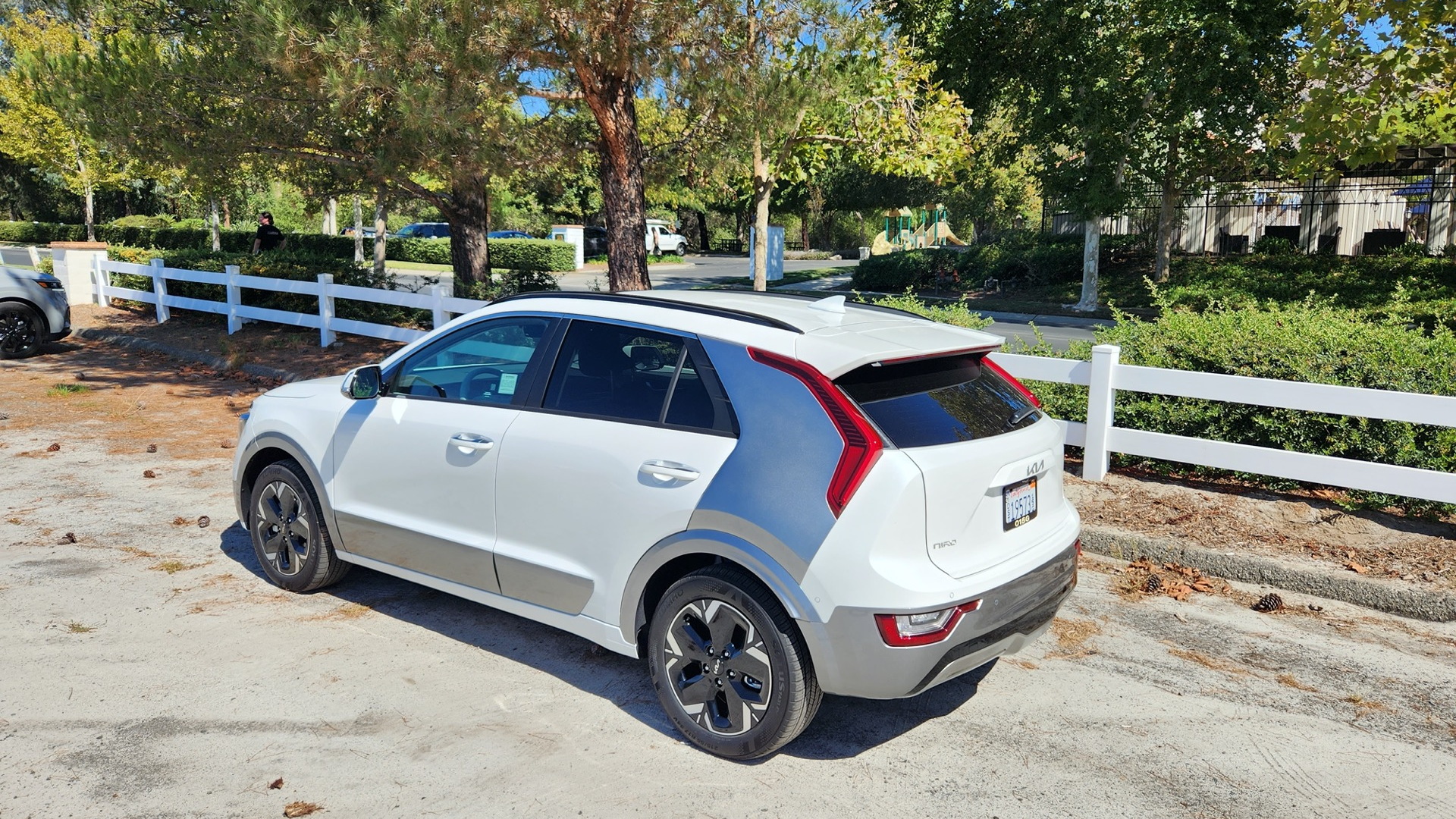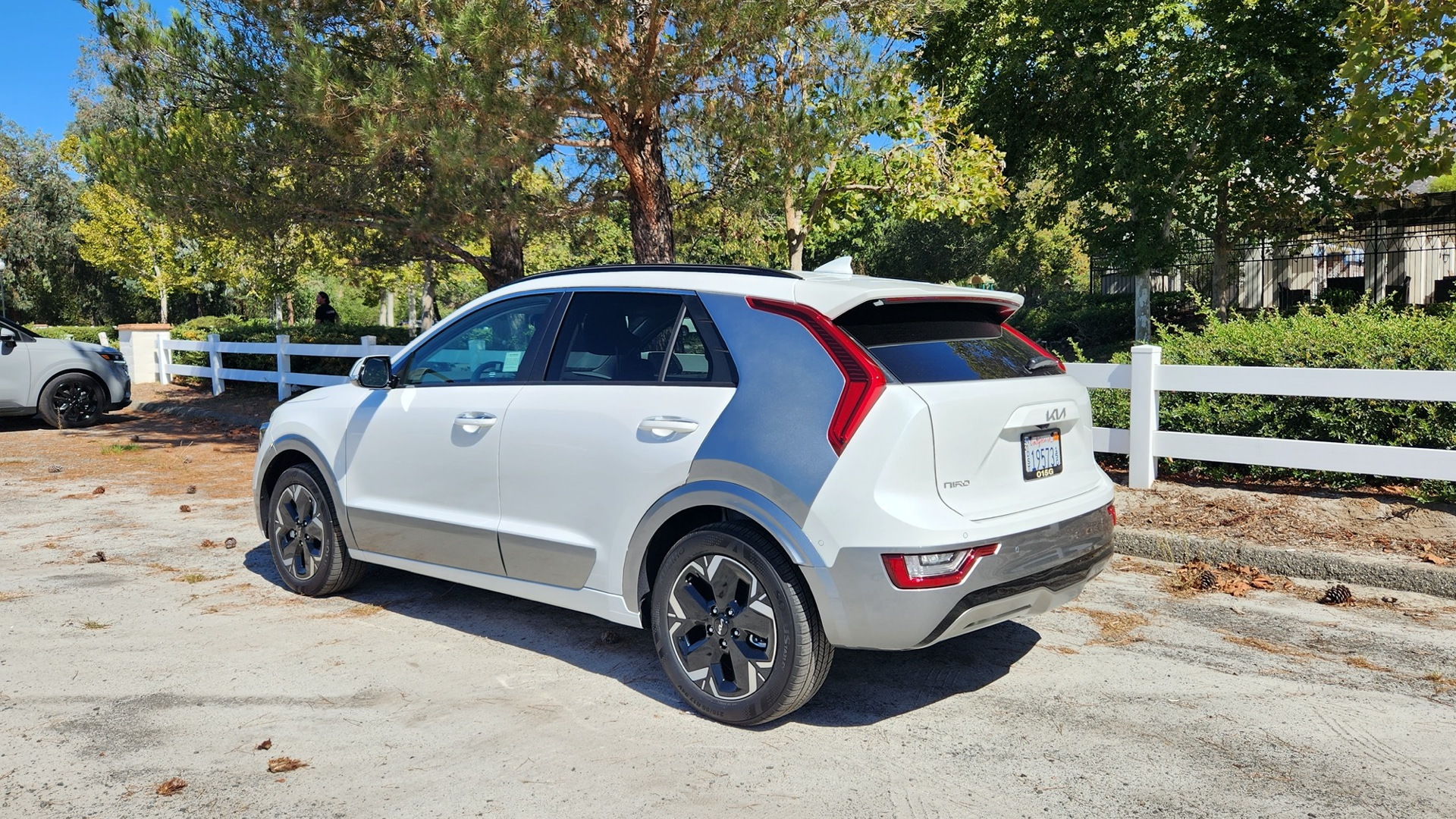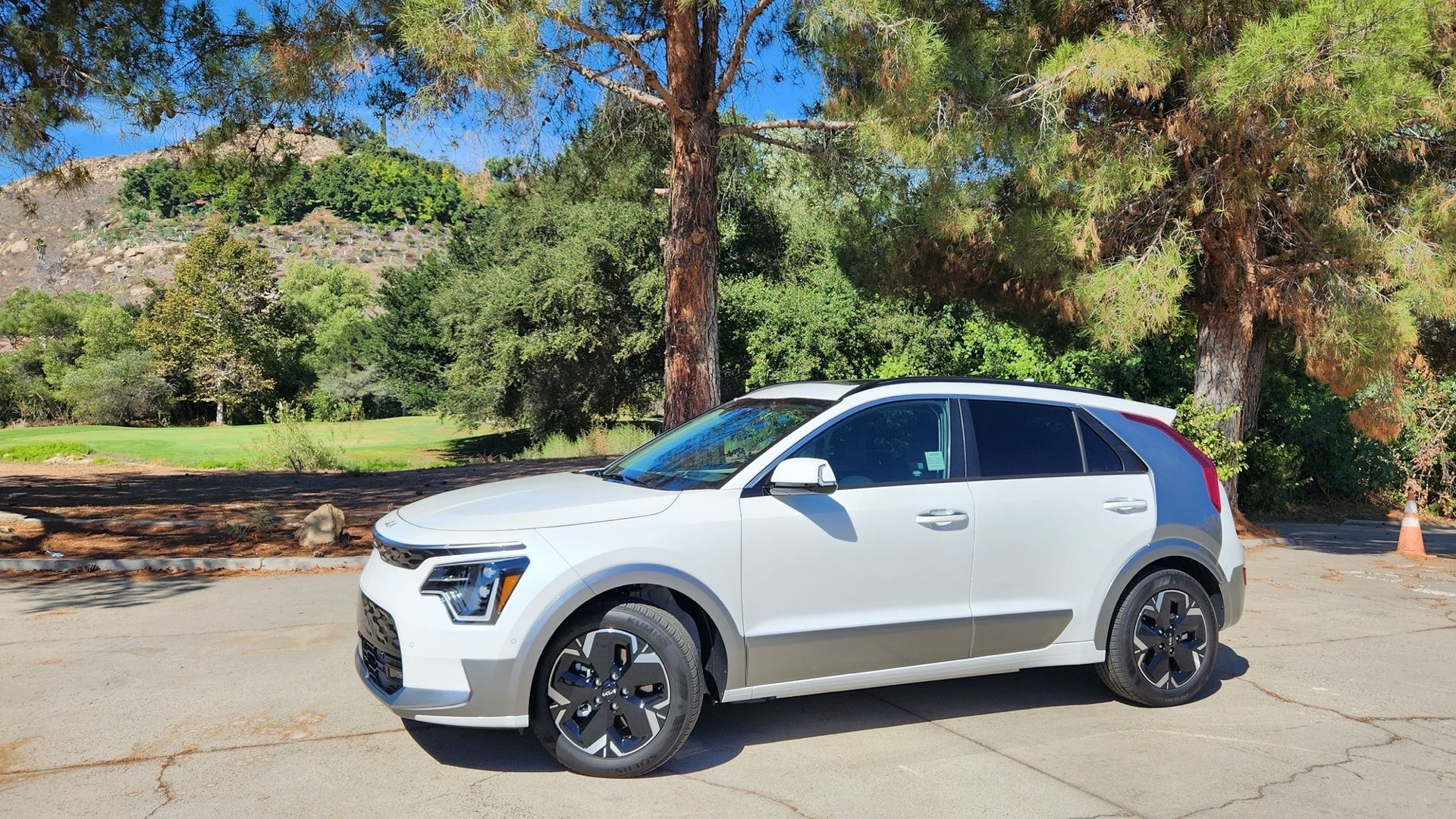The 2023 Kia Niro lineup is the second generation of the Korean brand’s most energy- and fuel-efficient model. Like the Niro that first arrived in 2017, it’s offered in hybrid, plug-in hybrid, and battery electric versions.
On sale now, the 2023 Niro Hybrid is the least expensive, starting at $27,785 and topping out around $35,000 (all prices include a mandatory $1,295 delivery fee). With an EPA-rated fuel economy of 53 mpg combined, it gives the legendary Toyota Prius a run for its money. The two differ in many ways, one being that the new Niro’s shape is relatively conventional—despite the distinctive contrasting “air blade” on each rear side.
The electric 2023 Niro is the best of the three in energy efficiency, and the quietest, though it’s also likely to be the priciest. (Kia hasn’t yet released prices for the Niro EV, which—along with the PHEV—will arrive in one to two months.) Its EPA-rated combined range is projected to be 253 miles. It competes with the Chevrolet Bolt EV and Bolt EUV, as well as the Hyundai Kona Electric, with ranges of 259, 247, and 258 miles respectively. Consider the Niro EV our substitute for the Kia Soul EV sold in other markets; that Soul will not come to North America.
Starting at $35,035 and topping out around $40,000, the 2023 Niro PHEV gives the plug-in Prius Prime stiff competition, with a 33-mile range rating that beats the Prime’s 25 miles. The PHEV, though, will be the least common Niro. It’s projected to be just 10 percent of overall sales, while the Niro EV is expected to deliver fully one-quarter of total sales. The Hybrid comes in at 65 percent.
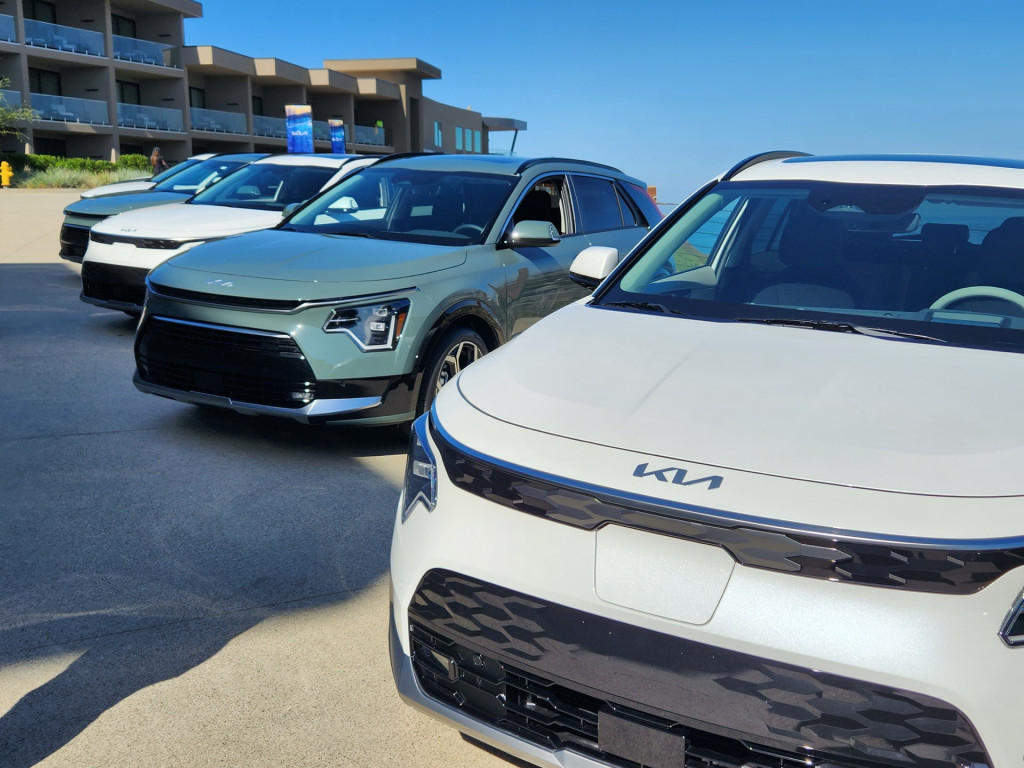
2023 Kia Niro EV
Kia says all three versions will be sold nationwide. With the advent of the pricier EV6 electric crossover, every Kia dealer is now certified to sell and service its models with plugs. We think the new Niro will do well, with the electric model potentially the sleeper in the lineup—if the company can supply enough volume to meet demand.
Air blades: for aero, and for style
The design of the 2023 Kia Niro was previewed by the Kia Habaniro electric crossover concept of 2019, especially the chevron-shaped accent in a contrasting color (silver or black) that sweeps from the roof down the rear pillar to the wheel well. It’s a polarizing feature: among both reporters and onlookers, some disliked it while others loved it.
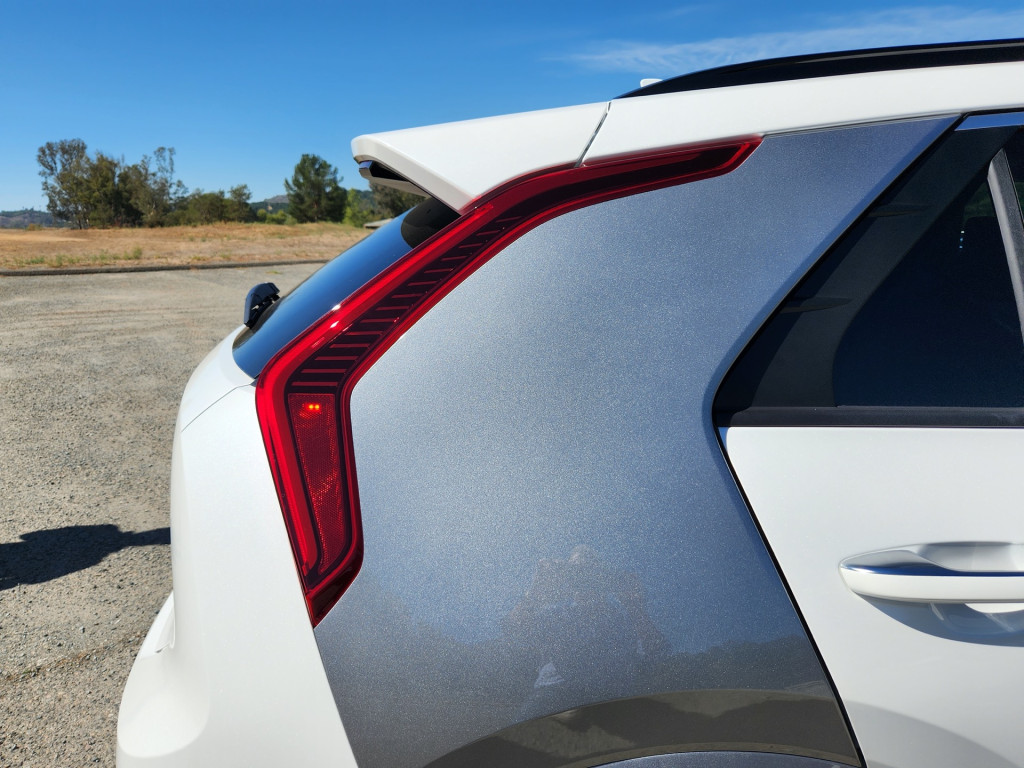
2023 Kia Niro EV
The swoosh shapes serve two purposes: First, they’re actually blades that channel airflow along the Niro’s sides and direct it past the tailgate to reduce aerodynamic drag. You have to look closely to see the inlets and outlets—they’re hard to photograph—but it’s a clever trick. Second, because Kia has dispensed with the third side window that made the first-generation Niro look like a sleek wagon, the contrasting blade keeps the car from being just another slab-sided tall hatchback—which we suspect was the intention. A fairly long roof spoiler disguises the rake of the tailgate, adding to the Niro’s upright appearance.
Up front, the 2023 Niro leads with the brand’s most recent “tiger face” theme, with thin horizontal headlights connected by an accent line that reads as the slimmest grille on the road. It makes this rather tall, boxy car look wider. The boomerang-shaped taillights are almost as thin, though from the rear, we couldn’t help but see echoes of a Ford Focus hatchback from 20 years earlier.
The three powertrain versions have less on the outside to distinguish them this time around. Only different front ends, with the EV’s charge-port door front and center below the Kia badge, separate the various Niro varieties. (The PHEV charge-port door is in its left-front fender.) Just the PHEV has a tailgate badge identifying its powertrain; it’s absent on the hybrid and EV.
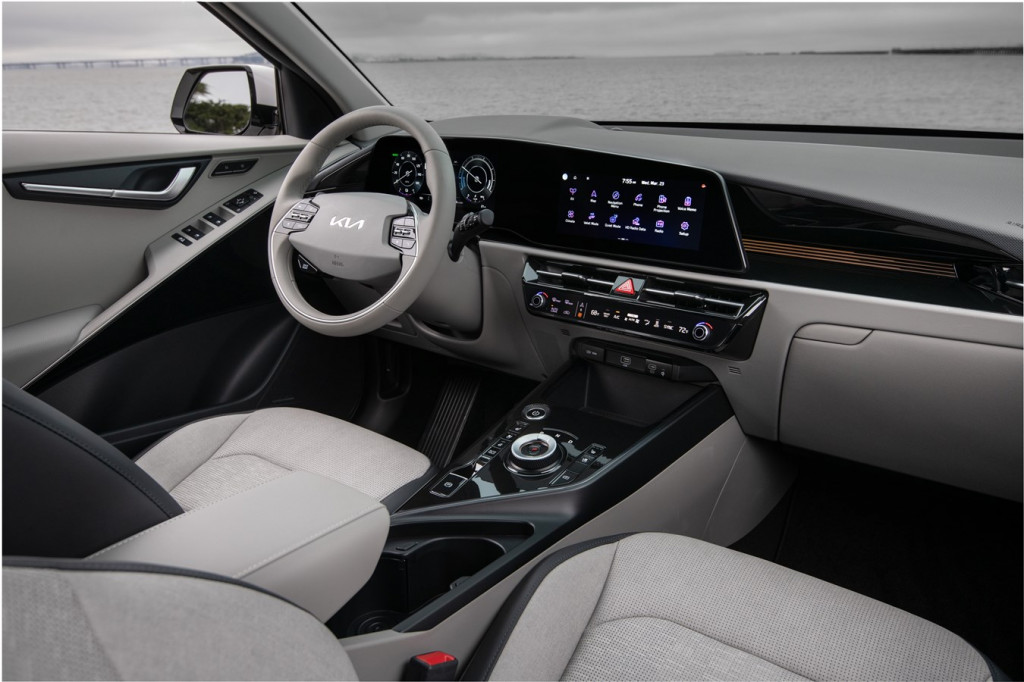
2023 Kia Niro EV
Inside, the dashboard traces a single arc from door to door, over both the instrument cluster and the 10.3-inch center touchscreen display (the lowest LX hybrid uses an 8.0-inch screen). Base hybrids have simple, all-black interiors with a conventional shift lever on the center console. At the other end of the scale, the top-trim EV models come with a rotary drive selector and two-tone interiors. Perhaps inevitably, there are large swaths of glossy “piano black” plastic trim in all models. It’s nice to look at, but it collects dust and fingerprints quickly. The chevron shape is repeated in parts of the interior design, including such things as the brushed-metal door handles.
While many shoppers will seek fuel efficiency or all-electric power, perhaps a few will be swayed by the new Niro’s commitment to more sustainable materials. The headliner is made from recycled wallpaper, the seats include eucalyptus leaves among ingredients for their materials, and the door paint is said to have a lower impact on the environment. A synthetic leather interior is offered on the top trim.
Smooth, smoother, smoothest
All three Niro drive systems power the front wheels, but after that, they diverge considerably. The new 2023 Niro EV feels like the quickest of the trio, with a 64.8-kwh battery pack powering a 148-kw (201-hp) motor rated at 188 lb-ft of torque. Acceleration from 0 to 62 mph is quoted at 7.8 seconds, hardly Tesla-fast but acceptable for an affordable compact EV hatchback.
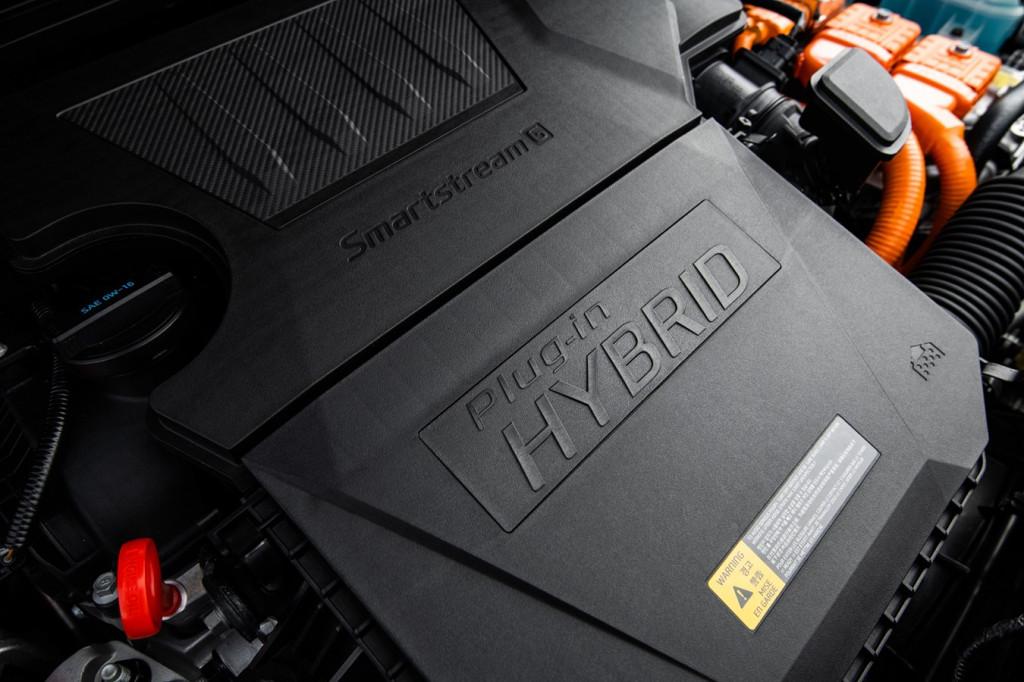
2023 Kia Niro plug-in hybrid
Both hybrids use a 1.6-liter inline-4 quoted at 139 hp and 195 lb-ft of torque, with an electric motor sandwiched between the engine and a 6-speed dual-clutch direct-shift transmission. The hybrid motor is rated at 32 kw, while the plug-in hybrid’s 11.1-kwh battery powers a 62-kw motor (41 hp more), that takes output to a combined 180 hp.
While the PHEV is almost 400 lb lighter than the EV’s minimum curb weight of 3,720 lb, its 0-to-62-mph acceleration of 9.6 to 9.8 seconds is still about two seconds slower. The hybrid is slowest of all, at 10.4 to 10.8 seconds, and we felt it on the road. It’s more apparent at highway speeds than in accelerating away from a light.
Watching the powertrain diagram carefully, we noted the PHEV retained 14 to 18 percent of battery charge once it switched over to hybrid mode. That keeps a large portion of the battery on hand to potentially supplement the gasoline engine, and subjectively it felt much quicker than the regular hybrid Niro.
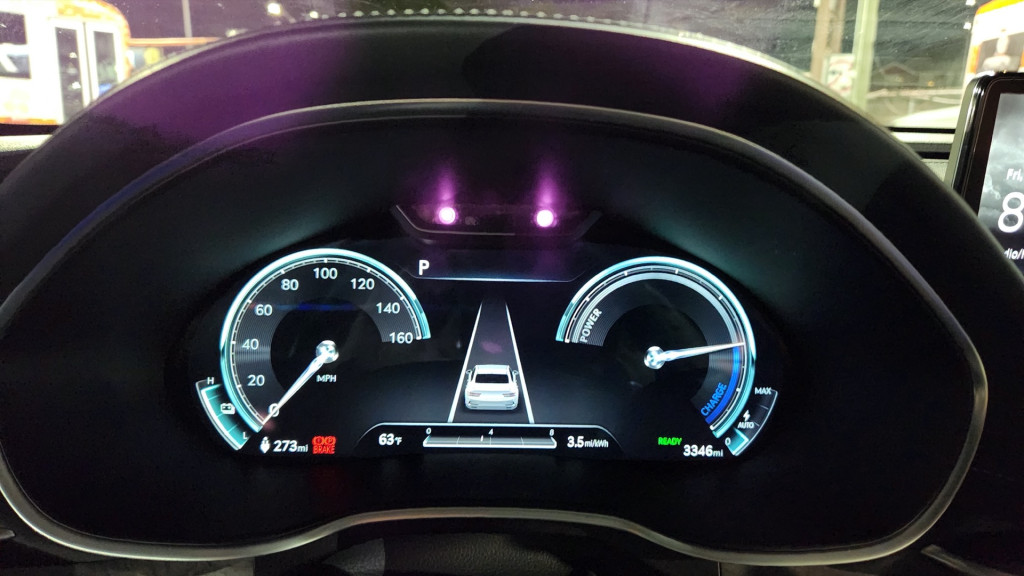
2023 Kia Niro EV
Speed is one thing, but powertrain smoothness is another. The two hybrids can’t approach the EV for smooth, continuous, quiet power, but the quality of the shifting in the transmission is remarkably good. It’s hard to make power transitions smooth in a single-motor hybrid system, where the motor can either power the car or act as a generator, but—unlike two-motor systems from Toyota or Ford—not both at the same time. Hybrid systems from Hyundai-Kia started out rough, but they now approach the smoothness of two-motor systems. That’s saying something.
All Niros have a “Drive Mode” button on the lower left-hand corner of the steering wheel hub. The PHEV has a console button offering a choice of Auto, Hybrid, or EV power. Combining Hybrid and the Sport mode lets drivers preserve battery charge for later use. The PHEV also has a left paddle that allows higher levels of regenerative braking.
Only the EV provides the “i-Pedal” one-pedal driving option. On our early-production test car, it wouldn’t activate at times and Kia wasn’t yet able to say why.
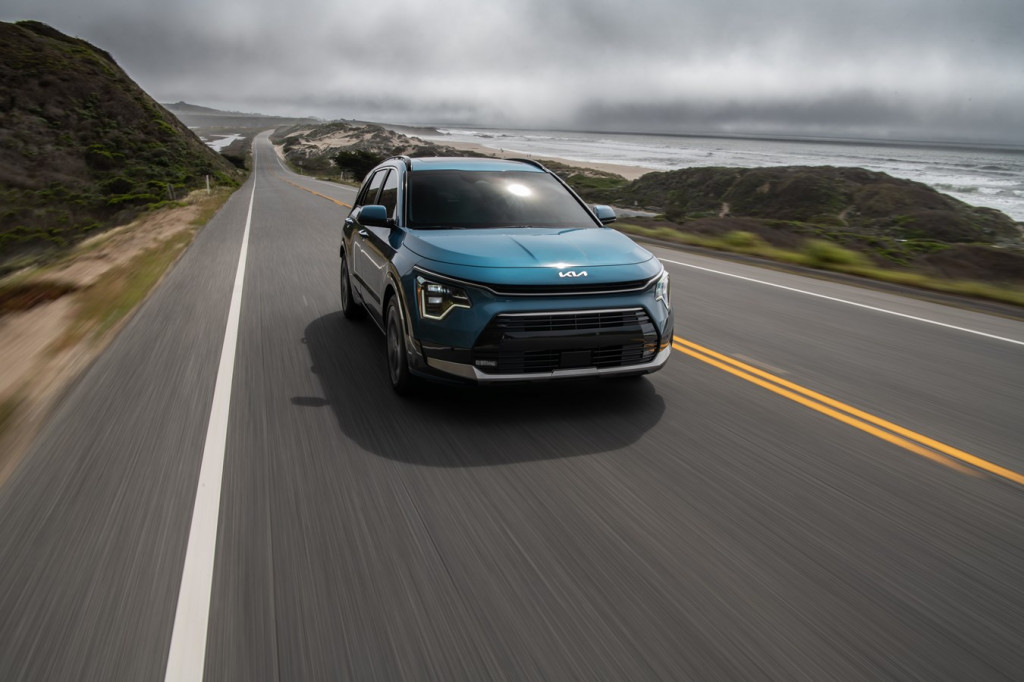
2023 Kia Niro plug-in hybrid
None of the Niros are particularly sporty in handling or roadholding. Driving all three back-to-back highlights how difficult it is to equip a vehicle with three different powertrains whose weight distribution varies considerably (the Honda Clarity was even worse in that respect).
Ample head room and leg room
We drove the Niro EV first, and found it the smoothest, calmest version—as we expected. It’s also by far the quietest, with admirable noise suppression for a modestly priced compact EV.
Interior room is good for what’s still essentially a tall compact hatch. (We can’t consider it a utility vehicle without available all-wheel drive, which isn’t offered.) My 6-foot-6 co-driver accommodated himself fine in the driver’s seat, but wasn’t able to sit behind himself in the rear—although at 5-foot-11, I was. One drawback to the rear seat is that the backs of the front seats are hard plastic, meaning there’s no give at all to accommodate rear riders’ knees.
Behind the wheel, the controls are clear and easily interpreted, with knobs for the most frequently used controls. Kia’s graphics and infotainment interface remains among the better designs in the business, and the Niro EV will be much easier for a novice electric-car driver to acclimatize to than, say, a Tesla with everything controlled from the central touchscreen.
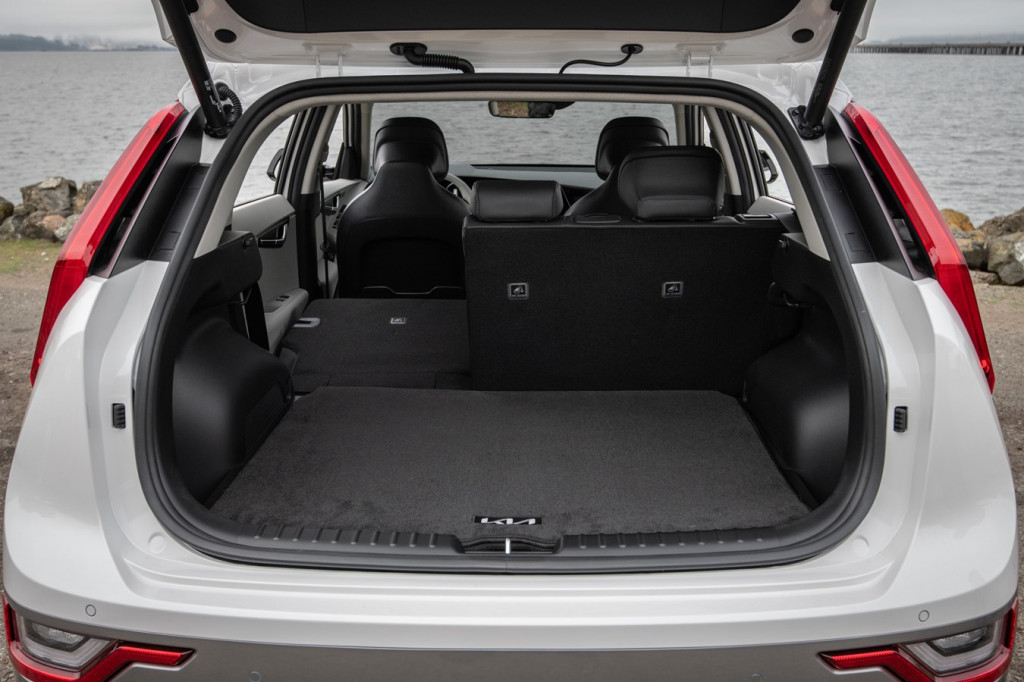
2023 Kia Niro EV

2023 Kia Niro EV
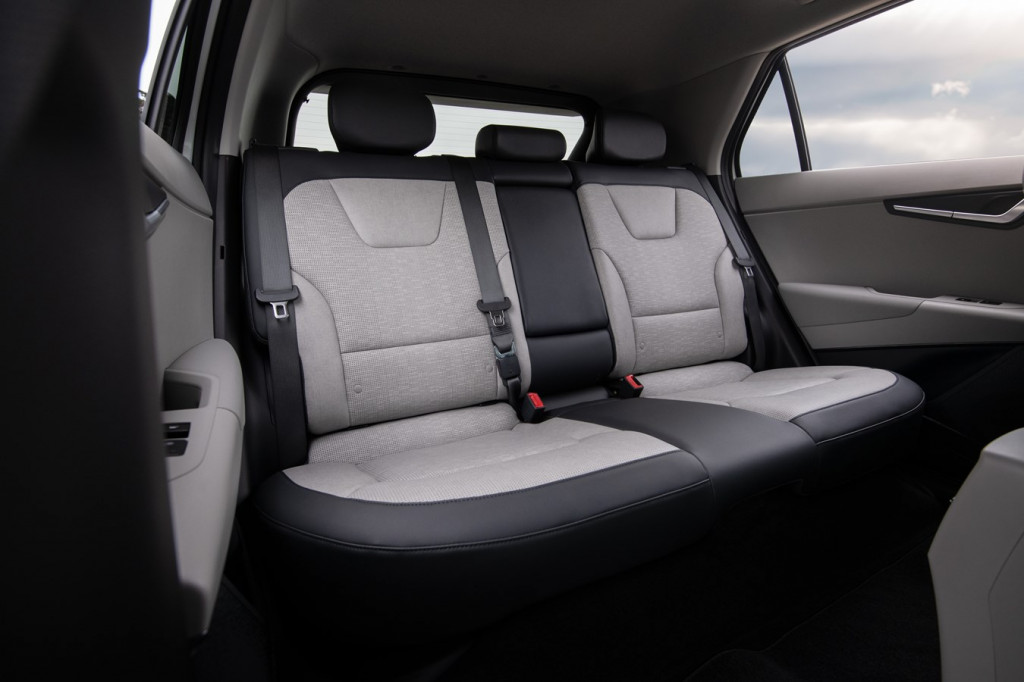
2023 Kia Niro EV
The Niro’s load floor is relatively high, but cargo volume for the hybrid and the EV is respectable: 22.8 cubic feet with the rear seat up, and 63.7 cu ft with the second row folded flat. That falls to 19.4 cu ft and 54.6 cu ft for the PHEV, with its larger hybrid battery extending under the load bay. The EV has its battery under the cabin floor, at the slight expense of less foot depth for rear-seat riders and some peculiar floor contours in the front passenger footwell.
Commendably, the Niro EV does have a bit of storage space up front. Under a square plastic molding that resembles nothing so much as an engine cover, there’s a shallow tray that looks like it would fit the portable charging cord, a couple of handbags, or perhaps a large canvas bag with squashable contents.
Standard safety systems
All models of the Niro come with what Kia terms its “DriveWise” bundle of driver-assistance systems, which packages eight separate safety features into a single system. They include blind-spot monitors and rear cross-traffic alerts, driver-attention warning, adaptive cruise control (on all but the base LX), automatic high beams, and automatic emergency braking.
The Highway Drive Assist II system adds active lane assist to adaptive cruise control but requires the driver to keep hands on the steering wheel; it’s optional on the EV only. Kia says the system learns a driver’s behavior over time, adjusting its behavior to match your observed driving style.
From low LX to…Wind and Wave?
The basic hybrid models are pitched as affordable to buy as well as operate, with prices starting at less than $30,000. But Kia has carefully packaged features, equipment, and options into groups that let buyers easily move up to more luxurious models.
The hybrid offers LX, EX ($2,600 more), and SX ($3,400 more) versions. The EX adds leather trim to the base cloth seats, a 10-way power adjustable driver’s seat, and heated front seats, while the SX adds synthetic leather, a power tailgate, and laminated front glass for quieter travel, among other features. An optional Touring Package for the EX and SX adds 18-inch alloy wheels and a variety of appearance items.
The versions with plugs have a simpler set of trims. The PHEV is offered in EX and SX grades, roughly corresponding to the hybrid’s, while the EV has a pair of grades called “Wind” (the base) and “Wave” (the higher level). Got that?
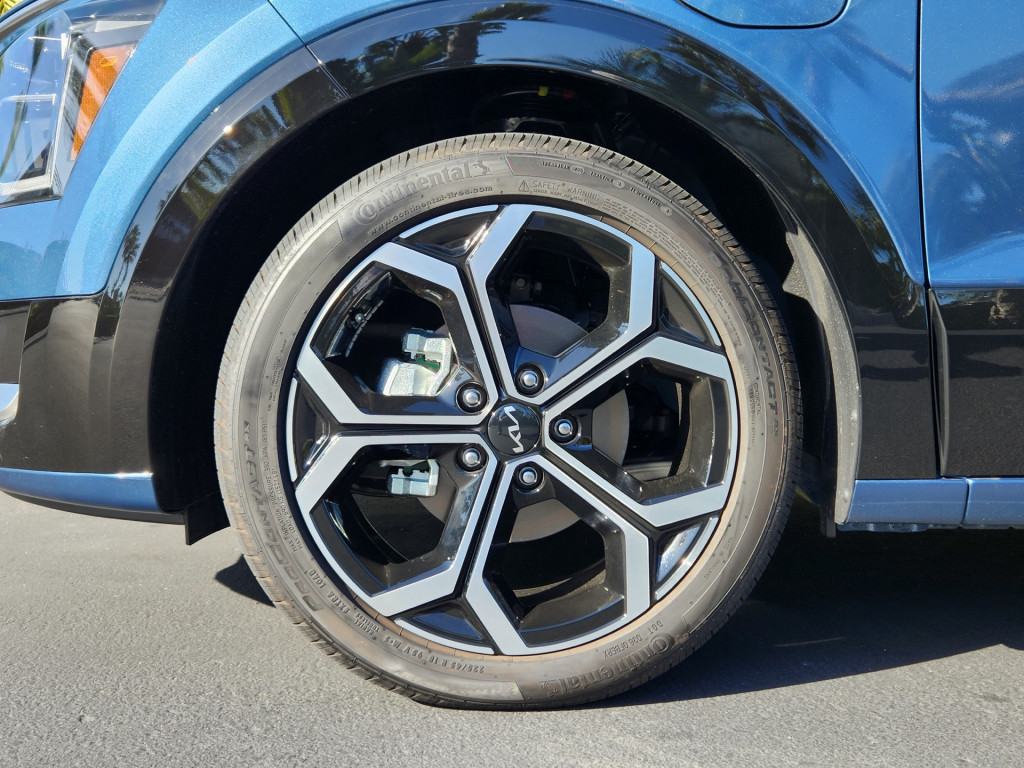
2023 Kia Niro Plug-In Hybrid
The two hybrids have standard 16-inch wheels, with 18-inch alloys a part of the Touring Package. Both Niro EV versions use 17-inch wheels. Wireless Android Auto and Apple CarPlay are standard on all models, as are USB ports on the sides of the front seats. Wireless charging is an option. Higher grades include use of a Digital Key on either a smartphone or an Apple Watch.
The Niro EV provides 120-volt power out via a standard U.S. AC socket, at up to 6.6 kw, the same as the EV6. We’ve used this function with a variety of small electrical appliances, and it works just as advertised.
Heat pumps and charging cords
The 2023 Niro hybrids include a “Green Zone” function that maximizes use of the electric motor when in school, hospital, or other emission-sensitive zones. Kia executives admitted that if the battery didn’t have much charge left, a “feather-light touch” on the accelerator is needed to keep the engine from switching on regardless.
A heat pump is optional on the Niro EV, to improve energy efficiency in colder weather. If a charging station has been entered into the navigation system as a destination, the EV can also preheat its battery to the optimal temperature for receiving charge at higher rates—shortening the overall stay for a given level of charge.
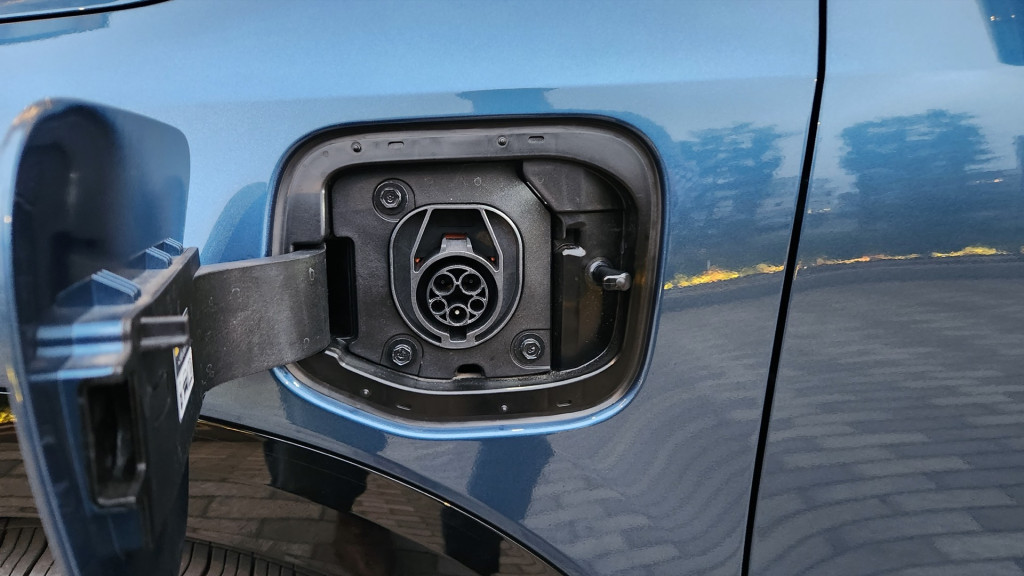
2023 Kia Niro Plug-In Hybrid
The PHEV takes less than 3 hours to refill its 11.1-kwh battery at a 240-volt Level 2 charging station. The EV offers Level 2 charging up to 11 kw, and DC fast charging up to 85 kw. Under ideal circumstances, fast charging will take the EV’s battery from 10 to 80 percent of charge in less than 45 minutes.
Kia announced that Niro EV drivers will receive 500 kwh of complimentary DC fast charging on the Electrify America charging network—a better offer, EV advocates say, than the unlimited free fast charging offered by some other makers, which runs the risk of discouraging owners from charging at home overnight as their primary recourse. Both the EV and PHEV versions come with a standard 120-volt portable charging cord—something Kia has made a dealer-installed option on its EV6.
--
Kia provided airfare, lodging, and meals to enable Green Car Reports to bring you this first-person test drive review.

